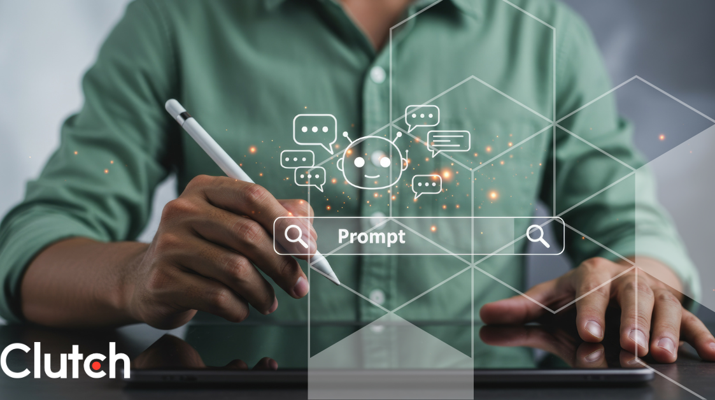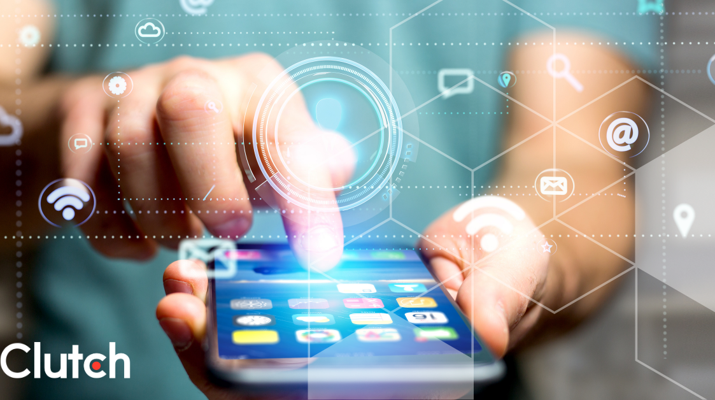

Updated December 12, 2024
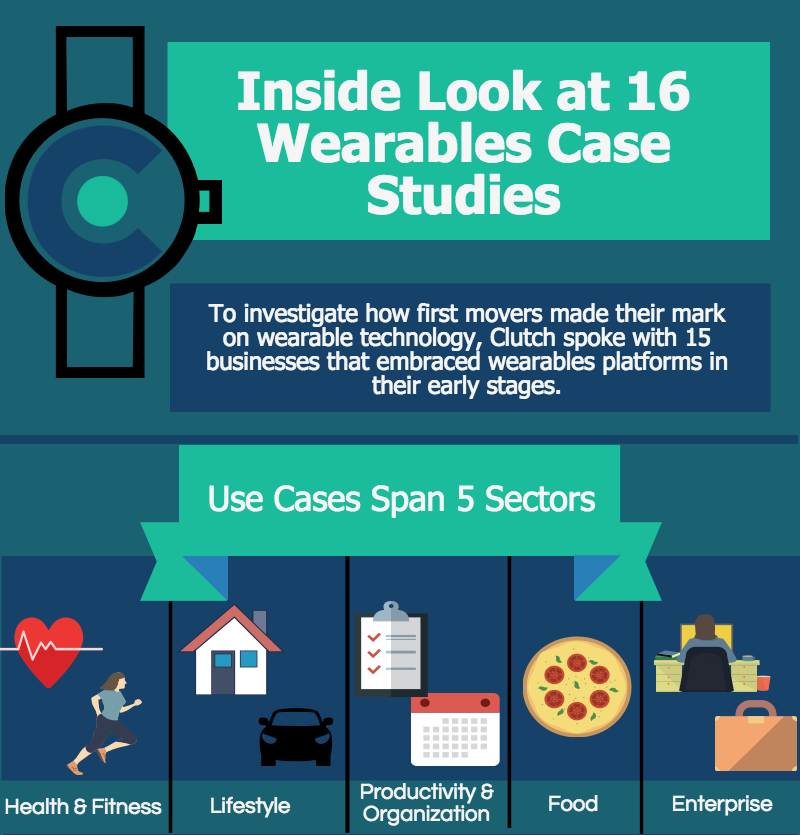
Looking for a Mobile App Development agency?
Compare our list of top Mobile App Development companies near you
Despite the initial novelty of wearable technology and devices, which include watches, wristbands, jewelry, clothing, and glasses, early projects embraced the challenges of designing for a new platform and ultimately unveiled a variety of unique use cases for wearables.
How businesses applied wearable technology to accomplish specific goals, extend their brands to larger audiences, and make their mark as lead innovators on a new platform, highlights the potential for wearable technology to make significant and lasting changes to how we live our lives.
Clutch spoke with 15 companies that embraced wearable technology in its early stages. A series of case study interviews revealed 16 unique use cases for wearables that span five sectors: health and fitness, lifestyle, productivity and organization, food, and enterprise. These early case studies hint at the rich future of wearable technology.
The most recognized and talked about use case for wearables centers on health and fitness. However, case studies reveal that wearables make their mark as more than just activity trackers that collect data. Rather, they impart meaning and context to personal data that has the potential to improve lives.
Activity Tracking
Runtastic, a fitness and lifestyle technology company with more than 15 fitness tracking applications, created a wearable device, the Orbit, which records a person's daily movements and aggregates the data in a mobile application, the Runtastic Me app.
Stephanie Peterson, vice president of strategic communications and marketing at Runtastic, explained how the Orbit differs from other wearable activity trackers on the market.
“We wanted to make the Orbit an activity and fitness tracker that was more flexible than some of the other products on the market. We wanted to make sure that people could customize it and integrate it into their daily life and style easily.”
— Stephanie Peterson
The Orbit sets itself apart from other fitness trackers on the market for a number of reasons.
For example, users can choose three wristband colors and easily change them to match their style, outfit, and activity.
Weight Loss

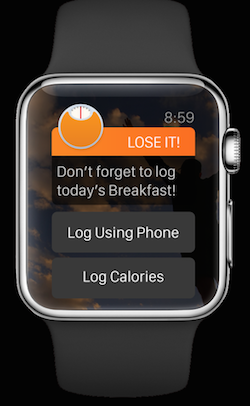
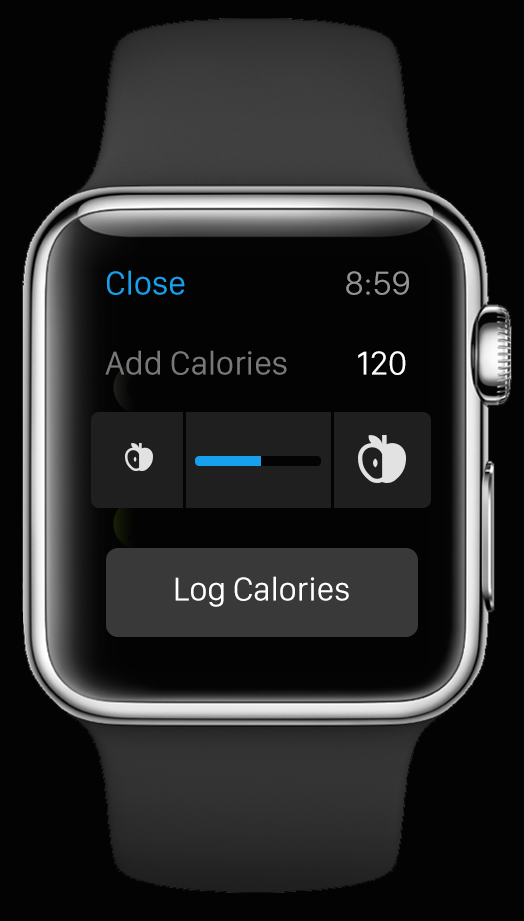
Source: Lose It!
Lose It! is an application-based service that strives to help people lose weight and maintain a healthful lifestyle.
Through digital mediums, Lose It! offers a number of services, including the ability to log meals, count calories, engage with a like-minded community, enter challenges, and receive reminders about and reports on weight loss goals.
The wearable application provides users with a simplified method of monitoring daily calorie and nutrient intake and encouraging meal tracking.
“We didn’t do what many other app developers have done – shrink our regular version down to a smaller scale – rather, we worked to build a new app that delivers the most critical components to our members. These features include detailed personal insights, quick tap logging, and easy meal tracking. They aim to enhance members’ abilities to stay healthy from their Apple Watches.”
— Charles Teague, Founder and CEO, Lose It!
Significantly, Lose It!’s platform works in tandem with a variety of popular health and fitness devices and technologies, including Google Fit, Jawbone, FitBit, Nike, Misfit, Withings, Strava, MapMyFitness, Apple Health, and Runkeeper.
They even offer a Bluetooth connected scale to facilitate uploading data to the application.
“The Lose It! scale is Bluetooth enabled and automatically syncs a person’s weigh-in to the Lose It! app. Our scale also monitors body fat and hydration levels.”
— Charles Teague, Lose It!
Medication Tracking
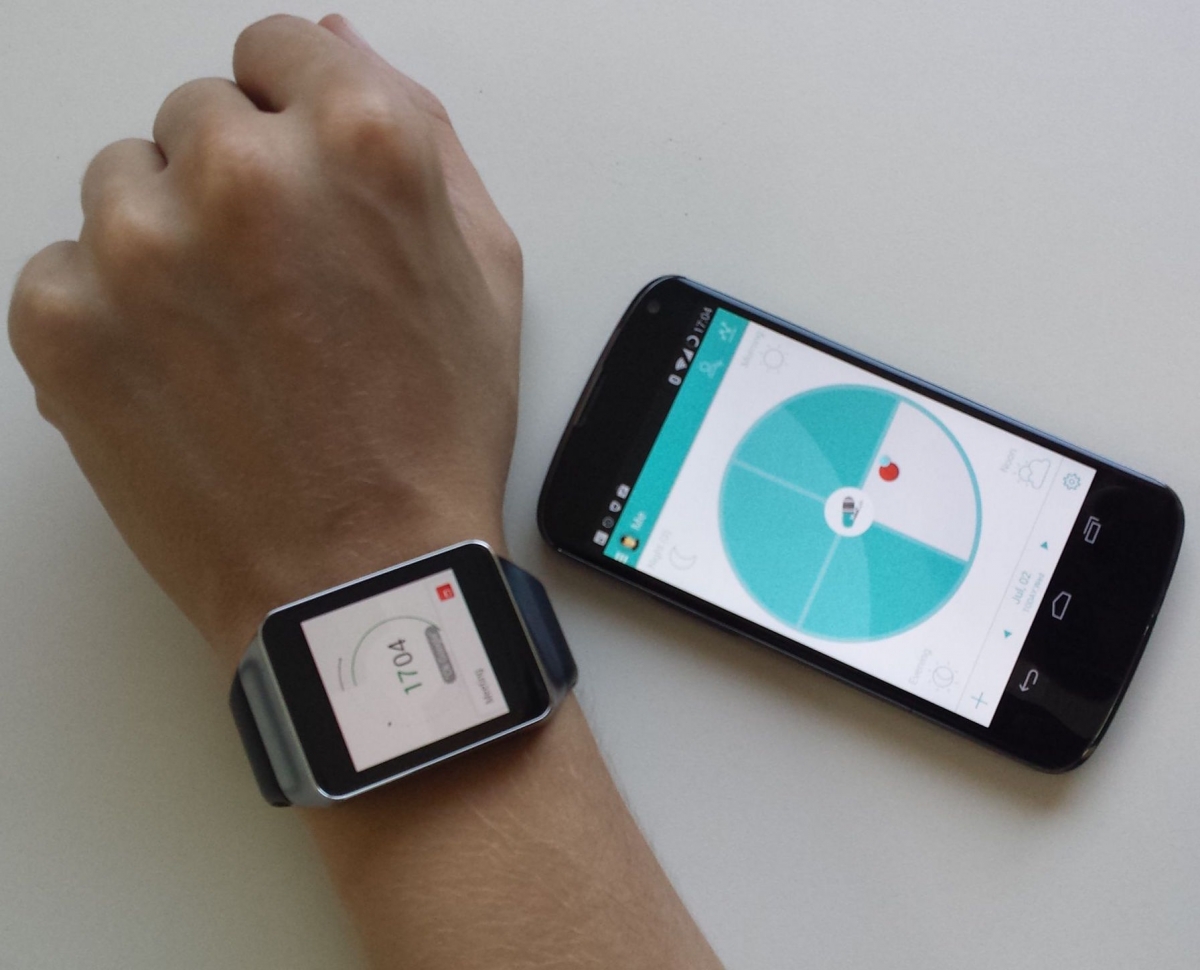
Source: Medisafe
Medisafe is a mobile platform that helps patients adhere to their medication regime. It aims to address the problem of non-adherence by bolstering a patient's continuum of care through technology, specifically through mobile and wearable applications.
“Non-adherence isn't just an issue of forgetfulness. It's an issue of medication affordability, the existence – or lack of existence – of a support system, and patients' comfort level in taking their medications. Patients want to see positive results arise from putting a chemical – their medication – into their body. For example, when they take their medication, their health improves.”
— Jon Michaeli, Head of Marketing and Business Development, Medisafe
Medisafe's mobile application includes four core features that shape the functionalities on the wearable counterpart.
Available on both Android Wear and Apple Watch, the Medisafe wearable application focuses on medication notifications and reminders through its Medications Feed.
“You can see what's coming up and what medications you're supposed to be taking next and receive notifications reminding you to take your medication at a specific time.”
— Jon Michaeli, Medisafe
Interactions on the wearable include quick finger taps to indicate whether you took your medication: 'Yes, I took it; no, I didn't take it; skip; dismiss.'
Virtual Doctor Consultations
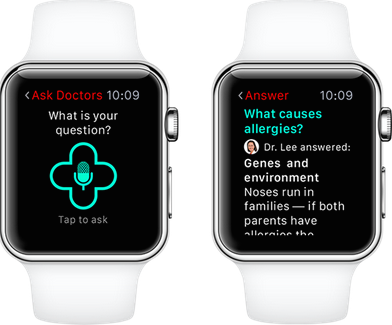
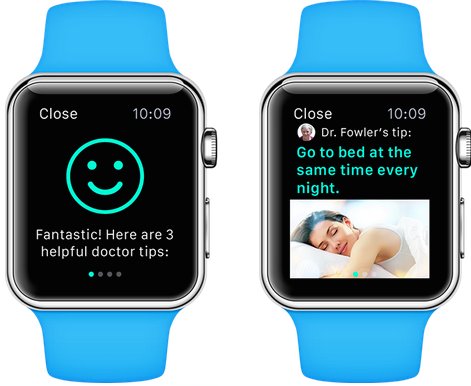
Source: HealthTap
HealthTap is a health management platform that provides consumers with comprehensive, virtual care.
The digital platform includes three core components.
The wearable application embraces the core components of the digital platform in a unique way, by giving the data collected meaning through context, according to Sean Mehra, head of product at HealthTap.
“There are doctors in our network, 72,000 of them, who have gone through sometimes 20 or 30 years of schooling, just to know what they know and practice this knowledge in clinical settings. When they look at data about your health, they can tell you how that informs your treatment or how that explains your symptoms. All of a sudden, the data becomes useful.”
— Sean Mehra
Additionally, the wearable application appeals to satisfying the need for information in the moment, through voice controlled health search capabilities.
“That's pretty cool because imagine the busy soccer mom juggling kids and groceries, and the kid starts crying. She's looking for her phone, but by glancing at her wrist, she can figure out what's going on quickly and ask what doctors think about the child's symptoms.”
— Sean Mehra, HealthTap
Geiger Counter for Illnesses
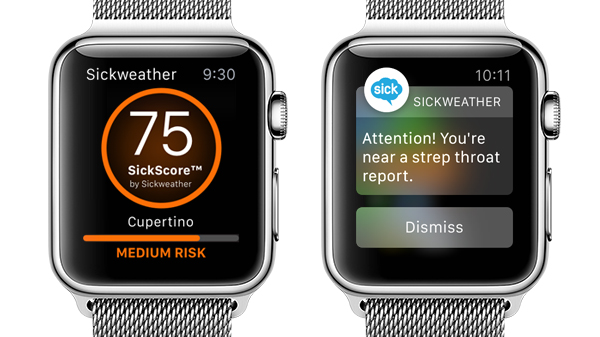

Source: Sickweather
Sickweather, the mobile platform that acts as a Doppler radar for illness, extended its reach to wearables for the Apple Watch release, June 2014.
Data collected by Sickweather's mobile platform derives from social media and crowd sourcing. Then, the data becomes incorporated into a real-time map of illnesses.
Graham Dodge, president and CEO of Sickweather, took advantage of the new platform to create an innovative, new feature, Sick Score, which he describes as a "Geiger counter for contagious illness."
“Our development team came up with the idea of this quick, easy-to-reference Threat Level Index – our Sick Score – that could look at all the data that we have in Sickweather within a certain mile radius of your current location and then calculate a Sick Score based on the reproductive scores of the contagious illnesses that we track.”
— Graham Dodge
The wearable application also features a list of the top three contagious illnesses in a specific area and a handwashing timer.
The handwashing timer in particular enables a user to take action when they are in an area with a high Sick Score.
“Tapping the 'Wash Hands' button launches a 20-second timer, a period the Centers for Disease Control and Prevention recommends for thorough handwashing and the mitigation of the risk of getting sick.”
— Graham Dodge, Sickweather
Hydration Tool
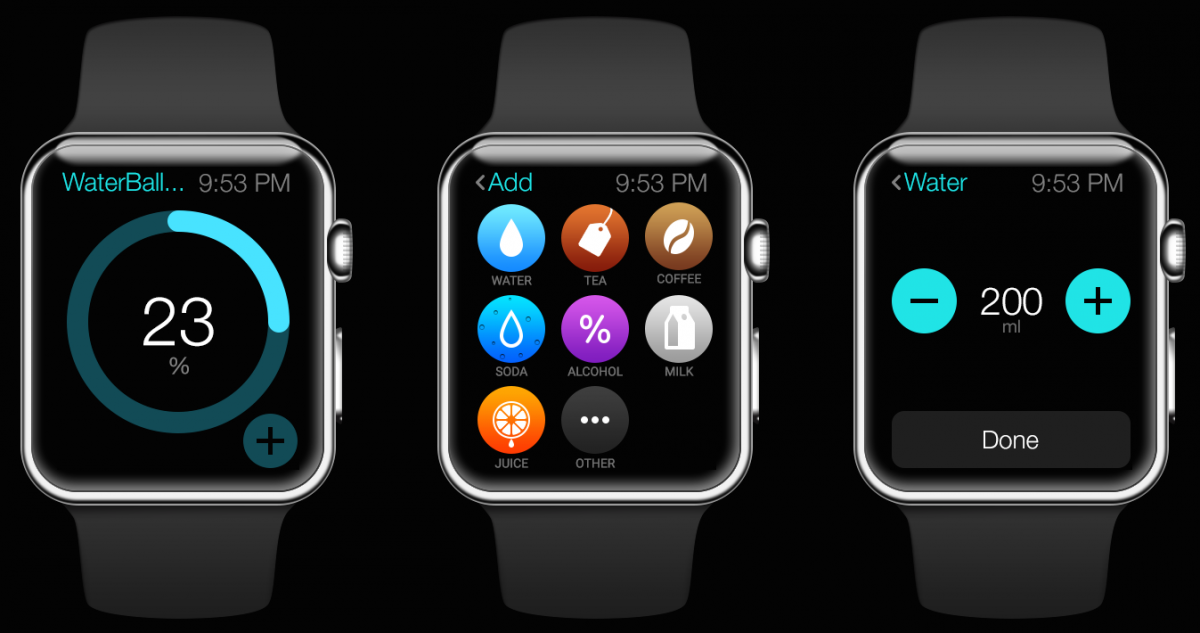
Source: Stanfy
Waterbalance, an Apple Watch application designed by app design and development company Stanfy, helps users track their water intake in order to improve hydration habits.
The wearable application is a companion to the original mobile application, which not only identifies the amount of water an individual needs based on height, weight, age, and level of physical activity but also allows users to record the beverages they drink to meet this goal throughout the day.
Andrew Garkavyi, CEO of Stanfy, described the Apple Watch as a convenient device to track hydration because of its location on the wrist.
“In the case of Waterbalance, we already had a working smartphone app with more than two million users tracking their water consumption daily. We felt that having a simple way to track water consumption was on the wrist, and this task would be a natural fit for Apple Watch.”
— Andrew Garkavyi
Pregnancy and Fertility Tracking
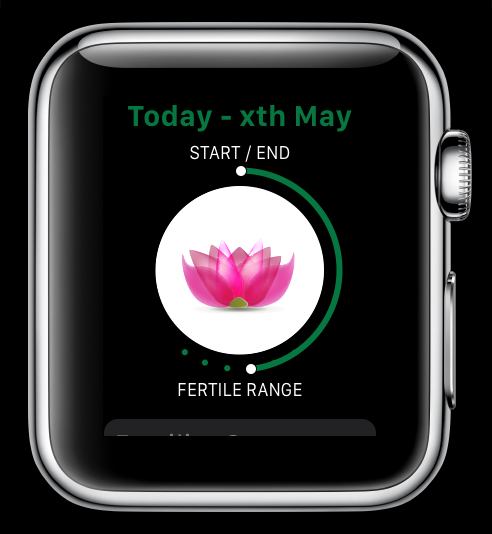
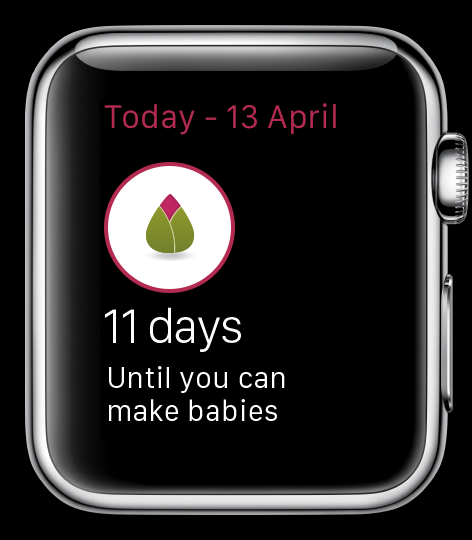
Source: Blue Label Labs
BabyMed, an independent pregnancy and fertility website, worked with application design and development company Blue Label Labs to extend its mobile application to the Apple Watch.
The mobile application features a fertility calendar and a pregnancy calendar to help users track, calculate, and prepare for a due date or ovulation date.
While the mobile application allows a user to track these dates in a number of ways, the wearable focuses on two features only.
1. The fertility tracker allows the user to check the status of her fertility using animations.
“With the BabyMed watch app, when you open the app, it tells you what cycle you're on and how fertile you are. It does this with an animation of a flower that's in different states depending on the fertility of the wearer.”
— Bobby Gill, Founder and CEO, Blue Label Labs
2. The pregnancy tracker identifies the user's current milestone and shows the length of time until she reaches the next landmark.
“It gives you 'pregnancy-at-a-glance,' we like to say. It is a very quick and easy way to see how far along your pregnancy is and what the next stage will be.”
— Bobby Gill
Wearables can simplify daily tasks, making them more convenient and easier to accomplish. From increasing mobility, to monitoring your car, to helping you find a new house, wearables use cases pervade the lifestyle sector.
Hands-free Device to Interact With Surroundings
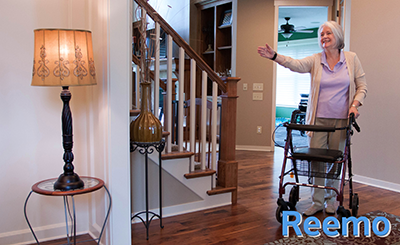
Source: Reemo
Reemo, through the Reemo device, enables hands-free interactions between an individual and his environment.
“We try to give caregivers and family members peace of mind by combining wearable technology, like smartwatches, with home platforms, like SmartThings or Nest.”
— Al Baker, Co-founder and CEO, Reemo
The Reemo Engine includes seven gestures that a user assigns to different devices. Typical examples include turning on the lights in a room, adjusting the thermostat up or down, and opening a garage door. In this way, Reemo enables individuals with limited mobility to live independently.
Mobile solutions firm MentorMate partnered with Reemo to build the software for the hub application, which allows interactions between the wearable wristband and connected devices throughout a personal space.
“The general idea is that you wear a wristband, and there are pods associated with connected devices distributed throughout a space – maybe your home or living room. When you point at a specific pod, it tells the Reemo device that you want to do something.”
— Ian Good, Senior Project Manager, MentorMate
Automotive Monitoring
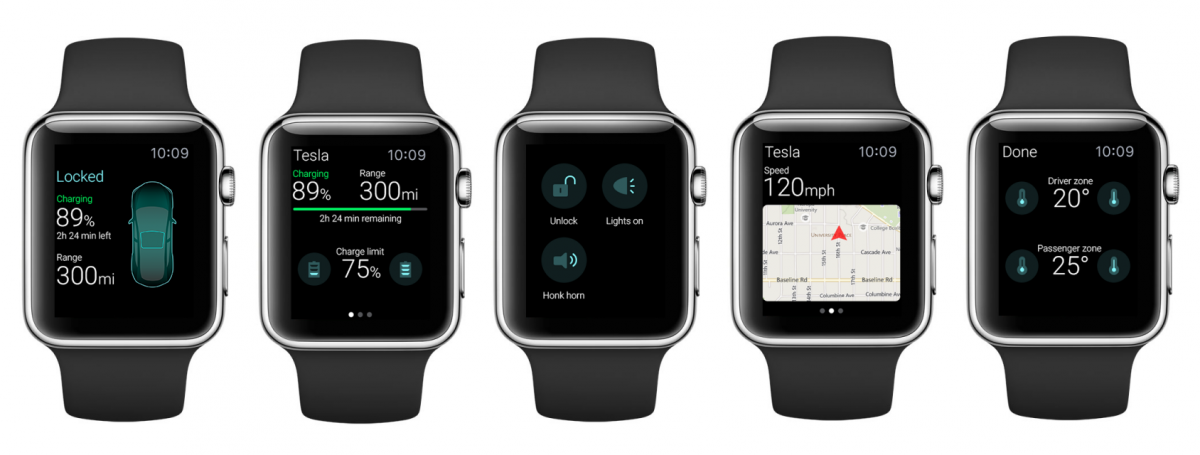
Source: ELEKS
ELEKS, a software engineering company, contributed to an Apple Watch application that allows Tesla car owners to control and monitor the car from their wrists. Capabilities include turning on or off the air and lights, tracking the car's location on a map, unlocking or locking the doors, and checking the charge status.
“We created it as an experiment to see how far we could push the Apple Watch's capabilities. The goal was to control the main functions of a car, like air conditioning, lights, map location, opening the car, and so on.”
— Markiyan Matsekh, Product Manager for mobility and wearables, ELEKS
The application allows car owners to monitor their cars and travel without having to pull out a smart phone to use the mobile application.
Exploring the Local Real Estate Market

Source: Plastic Mobile
Plastic Mobile, an application design and development company, set out to simplify the home-buying experience by developing a wearable application for Canada-based real estate company, Realtor.ca.
The wearable serves as a simplified version of the existing mobile application, which allows potential homebuyers to search an area for properties, monitor favorites, call an agent, and browse property images.
“The use case we anticipated [for the wearable app] is more that you're on the go and you need this information right in front of you on your wrist. We made it so that you can see all the images and information you need and then off you go.”
— Sep Seyedi, CEO, Plastic Mobile
The wearable features include quick scans to see what properties are on sale near you, the corresponding cost, and Realtor contact information. For the last feature, because the first version of the Apple Watch does not have the ability to place calls, the watch app communicates with its mobile companion to call the relevant Realtor.
Wearables can be used to increase productivity and facilitate organization in the users' personal and private lives.
Task Management
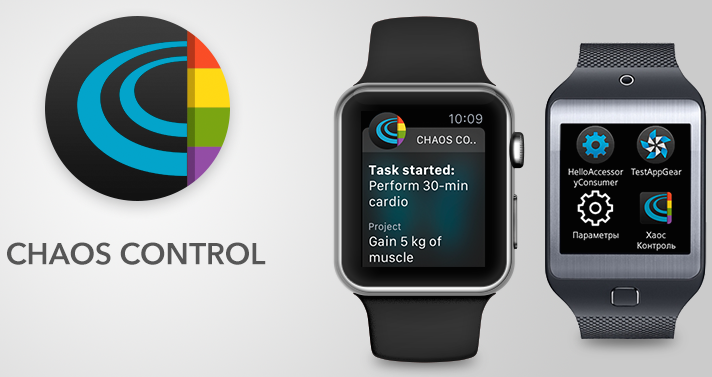
Source: Tarasov Mobile
Tarasov Mobile, in partnership with Touch Instinct, both Russia-based development companies, created Chaos Control, a tool that began as a mobile application and now is available on the Apple Watch, Samsung Gear, and Android Wear.
“Years ago, I quit my job as a software developer and decided to start my own business. … I realized that I wanted to create a tool for myself that was based on the GTD [Getting Things Done] methodology [by David Allen] and that would work on a full range of mobile devices and platforms.”
— Dmitriy Tarasov, Founder and CEO, Tarasov Mobile
While the mobile application allows a user to set personal goals, record tasks, and input schedules, the wearable app focuses on one core feature: the "Due Today" and "Due Tomorrow" task lists.
“The lists let you navigate through your tasks for today and tomorrow from your wrist. You also can mark any task as complete, leave snooze reminders, and add new tasks with your voice.”
— Dmitriy Tarasov, Tarasov Mobile
The release of the wearable application for Chaos Control increased adoption of its mobile counterpart, according to Dmitry Kostin, CEO of Touch Instinct.
“The wearable app … forces users to buy premium accounts because it’s the only way to use Chaos Control with watches.”
— Dmitry Kostin
Calendar
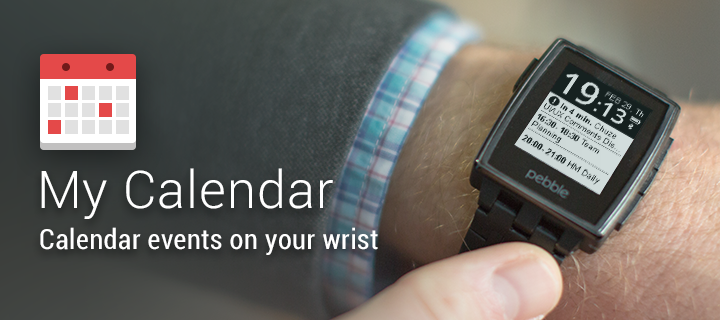
Source: Stanfy
Stanfy began experimenting with wearables on the Pebble platform with the creation of MyCalendar.
This application syncs with Google Calendar to improve users' productivity and organization. It displays the three nearest events from your calendar, a digital clock, the date, battery charge, and Bluetooth connection.
“We created the MyCalendar app to solve one of the pain points that other smartwatch users and us had – keeping up-to-date with our calendars. Pebble, at the time, didn't have any good integration with calendars, either on the phone or on the web.”
— Andrew Garkavyi, CEO, Stanfy
Event Enhancement and Management
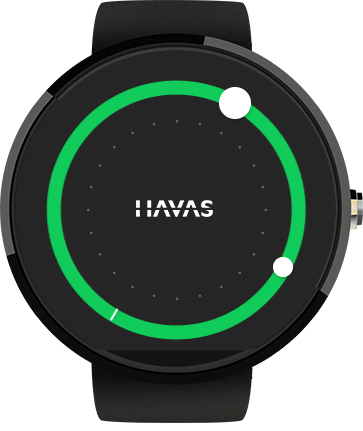
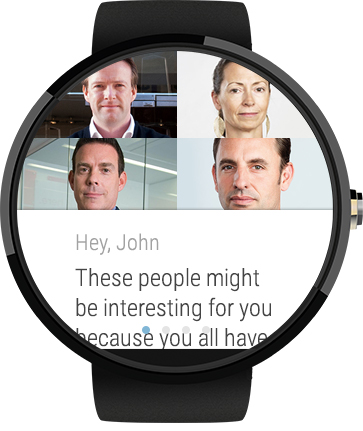
Source: ELEKS
Both Plastic Mobile and ELEKS explored how wearables can enhance an audience's experience at an event.
Plastic Mobile's initial experimentation with wearables occurred internally, when the company built a wearable device for its fifth anniversary celebration.
“When we started out, as part of our innovation lab, we built our own wearable device. We had our fifth anniversary, and we wanted to put a wearable device on everybody's wrist so we could track social interactions during the anniversary party. We put up a huge leaderboard, and we were able to track how many conversations people were having and how social they were being.”
— Sep Seyedi, Plastic Mobile
Similarly, ELEKS designed a wearable application for Havas, an advertising and communications company, for use throughout a company event. The application included an agenda, personalized notifications, and a customized watch face that displayed the company's logo.
“Each watch had a different colored watch face, and the color was based on the data we analyzed from the wearers' public social profiles.”
— Markiyan Matsekh, ELEKS

Source: Plastic Mobile
Wearables add another means of ordering food to a list that already includes over the phone, online, and through a mobile application.
Canada-based restaurant chain, PizzaPizza, worked with Plastic Mobile to extend its mobile application to a wearable, the Apple Watch.
“It's a pretty rich app in that it allows you to do everything that the actual smartphone version of the app does but is optimized to allow you to do it rapidly and with single taps.”
— Sep Seyedi, Plastic Mobile
Whereas most of the previous examples simplified the mobile application features to work on a wearable platform, PizzaPizza's wearable application maintained the majority of its mobile functionality.
“We looked at the features available on the smartphone and chose what functions we wanted to transfer to the wearable application. For example, we decided to include 'Last Order' and 'Favorite Order.'”
— Amar Narain, Head of Information Technology, PizzaPizza
Other features include a customized quick menu to place an order, access to the loyalty program, Club 11-11, and a delivery countdown.
“PizzaPizza is for when you're somewhere on your couch and you're too lazy to get on your phone, so you order a pizza on your watch.”
— Sep Seyedi, Plastic Mobile
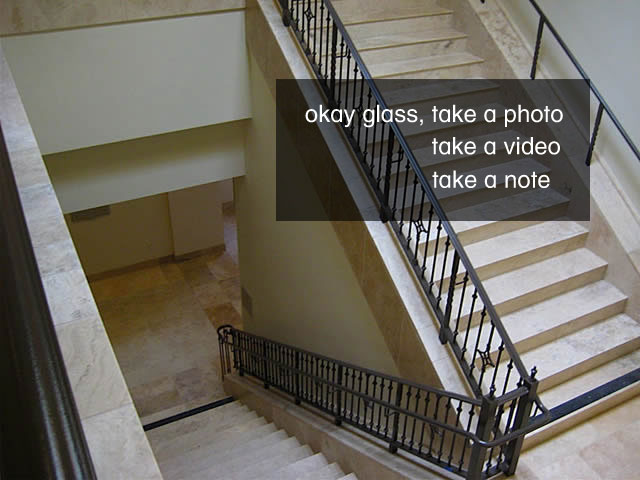
Source: Movel
Movel, a mobile app design and development company, demonstrates how wearable technology can help enterprises accomplish specific tasks more efficiently.
For example, one of Movel's clients, a service provider for professional integrators and installers that uses technology to enable the performance of site surveys, needed an easier way to take photos, videos, and notes and integrate them into a database. Movel identified Google Glass as the ideal platform to accomplish the company's goal.
“There were a couple of key features that made Glass one of the strongest choices, namely its ability to take hands-free photos and videos and to use gestures and voice commands. Voice dictation was particularly interesting because we wanted to have the ability to take notes during the surveys without using a tablet or paper.”
— Levent Gurses, President, Movel
As wearable devices continue to evolve and improve – an inevitable occurrence as Apple made evident with the unveiling of native app capabilities on the second version of the Apple Watch – the number of unique use cases will increase.
First movers already made great advances in applying wearable technology to accomplish business goals, enhance connectivity, and provide quality information and data. Specifically, the 15 companies interviewed demonstrate how wearables fit into and enrich five sectors: health and fitness, lifestyle, productivity and organization, food, and enterprise. Their projects hint at the rich future of wearables.
As the platforms progress and developers and businesses acquire more lessons learned from experimenting with wearables, the potential for more and better use cases is immeasurable.

